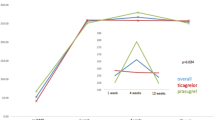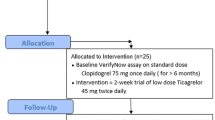Abstract
Background
Pelacarsen decreases plasma levels of lipoprotein(a) [Lp(a)] and oxidized phospholipids (OxPL). It was previously reported that pelacarsen does not affect the platelet count. We now report the effect of pelacarsen on on-treatment platelet reactivity.
Methods
Subjects with established cardiovascular disease and screening Lp(a) levels ≥60 mg per deciliter (~ ≥150 nmol/L) were randomized to receive pelacarsen (20, 40, or 60 mg every 4 weeks; 20 mg every 2 weeks; or 20 mg every week), or placebo for 6–12 months. Aspirin Reaction Units (ARU) and P2Y12 Reaction Units (PRU) were measured at baseline and the primary analysis timepoint (PAT) at 6 months.
Results
Of the 286 subjects randomized, 275 had either an ARU or PRU test, 159 (57.8%) were on aspirin alone and 94 (34.2%) subjects were on dual anti-platelet therapy. As expected, the baseline ARU and PRU were suppressed in subjects on aspirin or on dual anti-platelet therapy, respectively. There were no significant differences in baseline ARU in the aspirin groups or in PRU in the dual anti-platelet groups. At the PAT there were no statistically significant differences in ARU in subjects on aspirin or PRU in subjects on dual anti-platelet therapy among any of the pelacarsen groups compared to the pooled placebo group (p > 0.05 for all comparisons).
Conclusion
Pelacarsen does not modify on-treatment platelet reactivity through the thromboxane A2 or P2Y12 platelet receptor pathways.
Similar content being viewed by others
References
Tsimikas S, Fazio S, Ferdinand KC et al (2018) NHLBI Working Group Recommendations to reduce lipoprotein(a)-Mediated risk of Cardiovascular Disease and aortic stenosis. J Am Coll Cardiol 71:177–192
Tsimikas S, Moriarty PM, Stroes ES (2021) Emerging RNA therapeutics to lower blood levels of lp(a): JACC Focus Seminar 2/4. J Am Coll Cardiol 77:1576–1589
Tsimikas S, Karwatowska-Prokopczuk E, Gouni-Berthold I et al (2020) Lipoprotein(a) reduction in persons with cardiovascular disease. N Engl J Med 382:244–255
O’Donoghue ML, Rosenson RS, Gencer B et al (2022) Small interfering RNA to reduce lipoprotein(a) in Cardiovascular Disease. N Engl J Med 387:1855–1864
Nissen SE, Wolski K, Balog C et al (2022) Single ascending dose study of a short interfering RNA targeting lipoprotein(a) production in individuals with elevated plasma lipoprotein(a) levels. JAMA 327:1679–1687
Graham MJ, Viney N, Crooke RM, Tsimikas S (2016) Antisense inhibition of apolipoprotein (a) to lower plasma lipoprotein (a) levels in humans. J Lipid Res 57:340–351
Viney NJ, van Capelleveen JC, Geary RS et al (2016) Antisense oligonucleotides targeting apolipoprotein(a) in people with raised lipoprotein(a): two randomised, double-blind, placebo-controlled, dose-ranging trials. Lancet 388:2239–2253
Karwatowska-Prokopczuk E, Lesogor A, Yan JH et al (2022) Efficacy and safety of pelacarsen in lowering lp(a) in healthy japanese subjects.J Clin Lipidol
Price MJ, Berger PB, Teirstein PS et al (2011) Standard- vs high-dose clopidogrel based on platelet function testing after percutaneous coronary intervention: the GRAVITAS randomized trial. JAMA 305:1097–1105
Gross L, Aradi D, Sibbing D (2016) Platelet function testing in patients on Antiplatelet Medications. Semin Thromb Hemost 42:306–320
Roe MT, Armstrong PW, Fox KA et al (2012) Prasugrel versus clopidogrel for acute coronary syndromes without revascularization. N Engl J Med 367:1297–1309
Crooke ST (2017) Molecular mechanisms of antisense oligonucleotides. Nucleic Acid Ther 27:70–77
Benson MD, Waddington-Cruz M, Berk JL et al (2018) Inotersen treatment for patients with hereditary transthyretin amyloidosis. N Engl J Med 379:22–31
Witztum JL, Gaudet D, Freedman SD et al (2019) Volanesorsen and triglyceride levels in familial chylomicronemia syndrome. N Engl J Med 381:531–542
Tsimikas S, Viney NJ, Hughes SG et al (2015) Antisense therapy targeting apolipoprotein(a): a randomised, double-blind, placebo-controlled phase 1 study. Lancet 386:1472–1483
Baker BF, Xia S, Partridge W et al (2023) Integrated Assessment of phase 2 data on GalNAc(3)-Conjugated 2’-O-Methoxyethyl-modified antisense oligonucleotides. Nucleic Acid Ther 33:72–80
Liu H, Fu D, Luo Y, Peng D (2022) Independent association of lp(a) with platelet reactivity in subjects without statins or antiplatelet agents. Sci Rep 12:16609
Podrez EA, Byzova TV, Febbraio M et al (2007) Platelet CD36 links hyperlipidemia, oxidant stress and a prothrombotic phenotype. Nat Med 13:1086–1095
Price MJ, Endemann S, Gollapudi RR et al (2008) Prognostic significance of post-clopidogrel platelet reactivity assessed by a point-of-care assay on thrombotic events after drug-eluting stent implantation. Eur Heart J 29:992–1000
Michelson AD (2009) Methods for the measurement of platelet function. Am J Cardiol 103:20A–26A
Gurbel PA, Bliden KP, Butler K et al (2010) Response to ticagrelor in clopidogrel nonresponders and responders and effect of switching therapies. The RESPOND Study, Circulation
Byun YS, Lee JH, Arsenault BJ et al (2015) Relationship of oxidized phospholipids on apolipoprotein B-100 to cardiovascular outcomes in patients treated with intensive versus moderate atorvastatin therapy: the TNT trial. J Am Coll Cardiol 65:1286–1295
Byun YS, Yang X, Bao W et al (2017) Oxidized phospholipids on apolipoprotein B-100 and recurrent ischemic events following stroke or transient ischemic attack. J Am Coll Cardiol 69:147–158
McLean JW, Tomlinson JE, Kuang WJ et al (1987) cDNA sequence of human apolipoprotein(a) is homologous to plasminogen. Nature 330:132–137
Gries A, Gries M, Wurm H et al (1996) Lipoprotein(a) inhibits collagen-induced aggregation of thrombocytes. Arterioscler Thromb Vasc Biol 16:648–655
Barre DE (1998) Lipoprotein (a) reduces platelet aggregation via apo(a)-mediated decreases in thromboxane A(2)production. Platelets 9:93–96
Rand ML, Sangrar W, Hancock MA et al (1998) Apolipoprotein(a) enhances platelet responses to the thrombin receptor-activating peptide SFLLRN. Arterioscler Thromb Vasc Biol 18:1393–1399
Zhu P, Tang XF, Song Y et al Association of lipoprotein(a) with platelet aggregation and thrombogenicity in patients undergoing percutaneous coronary intervention.Platelets2020:1–6
Tsironis LD, Mitsios JV, Milionis HJ, Elisaf M, Tselepis AD (2004) Effect of lipoprotein (a) on platelet activation induced by platelet-activating factor: role of apolipoprotein (a) and endogenous PAF-acetylhydrolase. Cardiovasc Res 63:130–138
Salsoso R, Dalcoquio TF, Furtado RHM et al (2020) Relation of high lipoprotein (a) concentrations to platelet reactivity in individuals with and without coronary artery disease. Adv Ther 37:4568–4584
Lacaze P, Bakshi A, Riaz M et al (2022) Aspirin for primary Prevention of Cardiovascular events in relation to lipoprotein(a) genotypes. J Am Coll Cardiol 80:1287–1298
Dou H, Kotini A, Liu W et al (2021) Oxidized phospholipids promote NETosis and arterial thrombosis in LNK(SH2B3) deficiency. Circulation 144:1940–1954
Barre DE (2007) Arginyl-glycyl-aspartyl (RGD) epitope of human apolipoprotein (a) inhibits platelet aggregation by antagonizing the IIb subunit of the fibrinogen (GPIIb/IIIa) receptor. Thromb Res 119:601–607
Koltai K, Kesmarky G, Feher G, Tibold A, Toth K (2017) Platelet aggregometry testing: Molecular Mechanisms, Techniques and clinical implications.Int J Mol Sci; 18
Author information
Authors and Affiliations
Corresponding author
Ethics declarations
Disclosures
EKP, SX, and LL are employees of Ionis Pharmaceuticals and ST is an employee of Ionis Pharmaceuticals and UCSD. JLW is a consultant to Ionis Pharmaceuticals. JLW and ST are co-inventors and receive royalties from patents owned by UCSD on oxidation-specific antibodies and of biomarkers related to oxidized lipoproteins and are co-founders and have an equity interest in Oxitope, Inc and Kleanthi Diagnostics, LLC (“Kleanthi”). JY has no relevant conflicts.
Additional information
Publisher’s Note
Springer Nature remains neutral with regard to jurisdictional claims in published maps and institutional affiliations.
Electronic supplementary material
Below is the link to the electronic supplementary material.
Rights and permissions
Springer Nature or its licensor (e.g. a society or other partner) holds exclusive rights to this article under a publishing agreement with the author(s) or other rightsholder(s); author self-archiving of the accepted manuscript version of this article is solely governed by the terms of such publishing agreement and applicable law.
About this article
Cite this article
Karwatowska-Prokopczuk, E., Li, L., Yang, J. et al. On-treatment platelet reactivity through the thromboxane A2 or P2Y12 platelet receptor pathways is not affected by pelacarsen. J Thromb Thrombolysis 56, 226–232 (2023). https://doi.org/10.1007/s11239-023-02818-6
Accepted:
Published:
Issue Date:
DOI: https://doi.org/10.1007/s11239-023-02818-6




